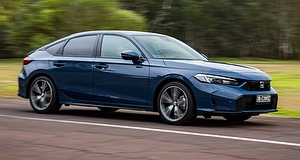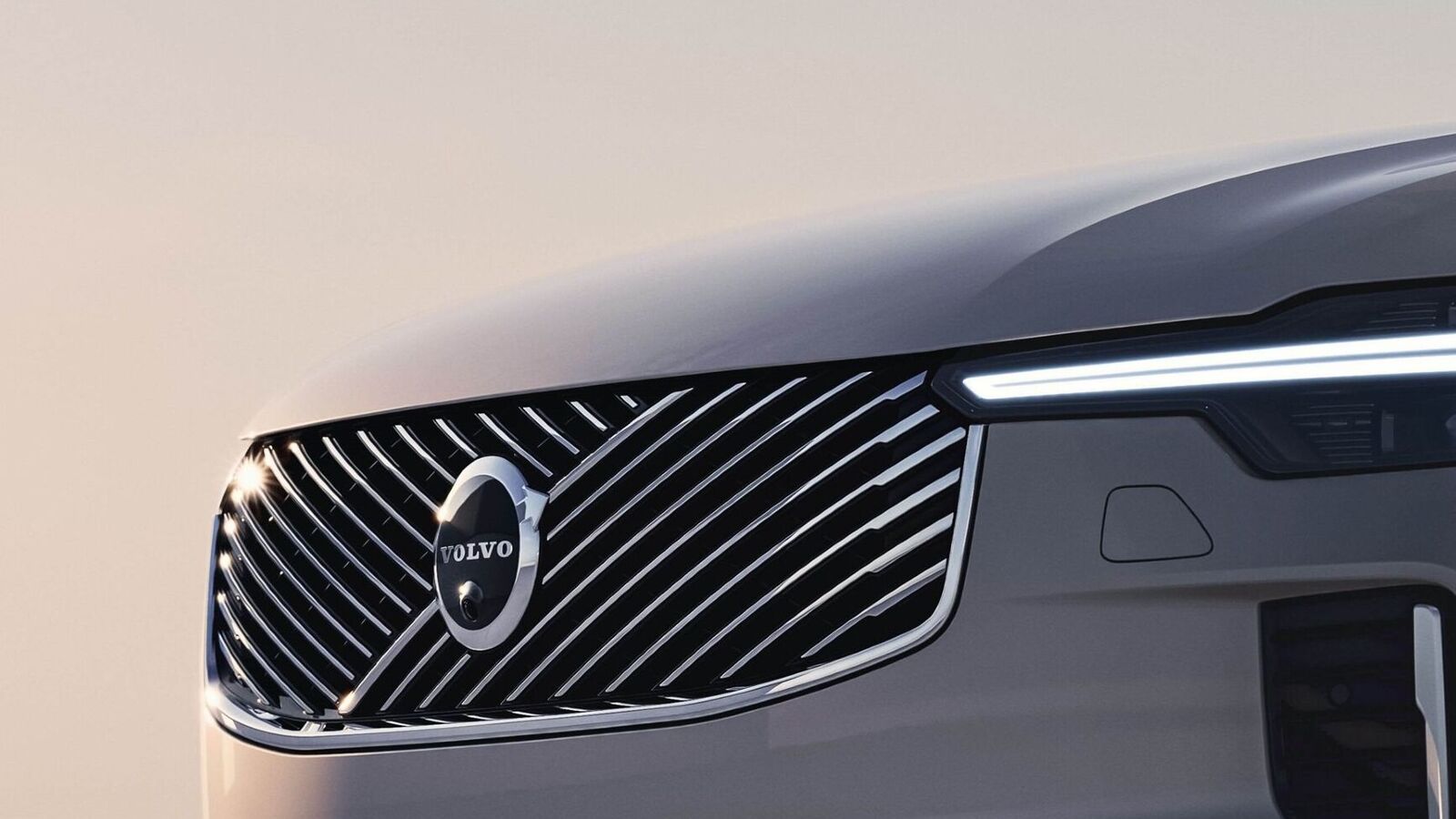Overview
HONDA updated its all-hybrid Civic small passenger range in December, adding an e:HEV L grade to the carryover e:HEV LX (as tested), which increased in price by $900 to $55,900 drive-away.
With additional features and more standard equipment than before – including next-generation Honda Connect and Google built-in technologies – the 2025 Honda Civic range is also visually refreshed with a reprofiled front bumper and body-coloured lower headlight garnishing.
The treatment is complemented by newly designed 18-inch alloy wheels (with tyre repair kit in lieu of a spare wheel).
As standard, equipment highlights include a 10.2-inch digital instrument panel, four USB-C charging ports, front and rear acoustic parking sensors, traffic sign recognition, intelligent speed assist, a heated steering wheel, auto up/down power windows, and a 9.0-inch infotainment touchscreen with Apple CarPlay (wireless), Android Auto (wired) connectivity, and an impressive 12-speaker Bose audio bundle.
Elsewhere, the entry variant offers auto folding and heated wing mirrors, LED headlights and DRLs, rear privacy glass, leather-accented and cloth combination upholstery in black, heated front seats, a leather-wrapped steering wheel, dual-zone climate control, and keyless entry and ignition.
The high grade Civic e:HEV LX adds a wireless phone charging pad, auto-dimming rear-view mirror, sunroof, leather-appointed upholstery in black, powered front seat adjustment, a chrome steering wheel inlay, sunglasses holder, leather door card inlays, front door card illumination, and an additional rear coat hook and seatback map pocket.
As before, the 2025 Honda Civic is powered by a 2.0-litre four-cylinder petrol engine and twin electric motor hybrid driveline driving the front wheels via an e-CVT transmission.
The system provides 135kW of power and 315Nm of torque with Combined cycle fuel consumption figure of 4.2 litres per 100km. Four drive modes are offered, including Econ, Normal, Sport and Individual.
Both Civic variants are equipped with a generous list of standard safety features as part of the Honda Sensing suite while the Advanced Compatibility Engineering (ACE) body structure is designed to better protect occupants and pedestrians in the event of a crash, the importer says.
For 2025, the Civic range is available in a choice of four paint colours including Platinum White, Crystal Red, Seabed Blue, and Sonic Grey (e:HEV LX only).
All Honda passenger cars are backed by a five-year/unlimited-kilometre warranty with included roadside assist and eight years of high-voltage battery cover. Service intervals are set at 12 months or 10,000km (whichever comes first), placing the Civic behind some rivals with a 15,000km distance interspace.
Maintenance costs are capped at just $199 per interval for the first five years, bringing the price of scheduled servicing to just $995 for the entirety of the warranty period – or $230 less than a comparable Corolla.
Driving Impressions
There is a lot to like about the Honda Civic. Mostly, it is a vehicle that feels classier and more civilised than its nearest rival – but one that is unfortunately far more expensive, meaning many buyers will simply look elsewhere.
Weighed against a competitively equipped Toyota Corolla ZR, the Honda Civic e:HEV LX is around $11,000 dearer when on-road costs are factored in. No matter how you cut it, that’s a lot of extra coin.
The Civic’s cabin is deceptively generous in terms of its passenger accommodation with far more room than its ‘small car’ descriptor might suggest. The low-slung seating position means there is sufficient headroom throughout, a scenario that further benefits the driver’s relationship with the vehicle’s primary controls.
We found the seating comfortable on longer trips, delivering plenty of support and adjustment. The heated seats (but no ventilation or memory functions) and steering wheel are a nice touch, as is the effective dual-zone climate control, and generously sized sunroof above.
On the downside, oddment storage is a little slim. With a mobile phone on the charging tray and a couple of drinks in place the console bin is the only remaining option for one’s keys, wallet, etc. Perhaps the area occupied by the unusual push-button gear selector could be better utilised in a future update.
The inclusion of USB-C outlets and rear-seat air vents kept back-seat passengers happy on an extended Easter road trip, the 60:40 split-fold function of the rear bench also useful in accommodating larger parcels.
Boot space is listed at 409 litres and is accessed via a manual liftgate. There’s a small underfloor storage area beneath, but no spare wheel, the Civic offering only an often-pointless tyre repair kit.
The tech interface further forward is updated to include Google built-in services including Google Assistant and Google Maps. Although it offers Apple CarPlay (wireless) and Android Auto (wired) we had continual issues with establishing and maintaining a connection with our iPhone 13 Pro.
We also found the menu system cumbersome, perhaps suggesting a greater level of familiarity is required to become proficient.
Interestingly, and although the illumination of the infotainment and instrumentation screens may be dimmed sufficiently, the hard buttons to the right of the infotainment cluster remain brightly lit at night – a small but annoying oversight Honda would do well to address.
Headlight performance is acceptable, rather than good, the low and high beam quite short of throw and spread. It’s a situation we found unnerving on dark country roads, suggesting perhaps the Civic is a vehicle primarily aimed at urban dwellers.
While the Civic’s ADAS systems were by and large hard to fault, we think Honda needs to take a good look at its speed limit recognition technology…
On test, the system took as gospel any roadside numbering as an indication of speed, including black-on-yellow advisory signs, and time-of-day speed limit signs set within a black circle. Systems from other OEMs can read only those figures set within a red circle, suggesting the Honda system may be a little way behind.
That aside, and as noted in previous road tests, the Civic e:HEV is an engaging and well-balanced vehicle that feels a step above its segment rivals. Power delivery is energetic yet smooth, the hybrid system favouring electric motivation in most scenarios to deliver impressively linear acceleration.
The Civic e:HEV responds accurately to throttle inputs and will almost mimic traditional gearshifts when called upon to hustle. The electric continuously variable transmission is stepped to provide perceptible ‘ratios’ in sportier driving – and when decelerating.
In concert with steering wheel mounted shift paddles, the Civic’s regenerative braking system is a useful partner in slowing for corners, while also benefitting the battery’s state of charge.
The vehicle’s friction braking is equally impressive with consistent pedal weighting and calculable pedal stroke progression. Offering such a sweetly modulated braking action enables settled and predictable retardation on flowing country roads and resolved stops in busy city traffic. In short, there’s no excuse for a jerky stop.
We also love the Civic’s direct and consonant steering feel and found the electrically assisted setup to be beautifully weighted in both town and country settings. Feedback is accurate, the system able to quell unwanted kickback from degraded road surfaces with very little deflection.
Unfortunately, the low-profile tyres make it difficult for the Civic’s suspension to absorb sharper edged bumps and potholes, impacting what is an otherwise well-balanced ride.
Given the agility and comfort the vehicle can offer on smoother surfaces, it’s disappointing this aspect of the Civic’s ride is overlooked, perhaps again highlighting a setup that is aimed at smoother urban roads, and not those farther afield.
The Michelin Pilot Sport 4 tyres fitted to the Civic are grippy, but incredibly loud on coarse chip surfaces, significantly detracting from the ambience of the cabin. We’d be very keen to try the Civic e:HEV LX on some different rubber to see if it addresses not only the level of noise in the cabin, but also the tyre’s ability to deal with unexpected bumps.
Importantly as a hybrid vehicle is the Civic e:HEV’s fuel economy. On an extended test comprising the weekly commute and a rural Easter road trip, the vehicle managed an impressive 4.5 litres per 100km – or just 300ml/100km more than the advertised number.
Running on regular 91RON unleaded petrol the Civic is fitted with a 40-litre fuel tank, equating to a range of almost 900km from a single fill.
While there is no doubting the impressive fuel economy, smooth and adequate power, well-balance ride, and spaciousness of the updated Honda Civic, the vehicle’s shorter service mileage, unreliable speed limit recognition, and unacceptable tyre noise create significant hurdles to potential ownership.
As good as it is, the Civic’s shortfalls and excessive list price will continue to see it overlooked by Aussie buyers – an unfortunate case of ‘close, but no cigar’ if ever we have seen one.




